Europe‘s first inland ferry with pure gas propulsion goes into regular service on Lake Constance. HEROSE valves are on board.
The Constance – Meersburg ferry service has been in service since 1928 and was a success story right from the start. Now Constance Public Services is putting the „Richmond“, a new ferry with LNG gas propulsion, into service.
The sky above Lake Constance shines the brightest blue, the water glistens in the sun and when the new ferry departs for Meersburg, not the smallest cloud of smoke appears above the ship. The new Lake Constance ferry has two high-speed MTU gas engines. The engines run exclusively on LNG (Liquefied Natural Gas), emitting no soot, no sulphur oxides, significantly less nitrogen oxide and fewer greenhouse gases. In future, the new ship can also be operated with bio-LNG from renewable energies, in which case it will be largely climate-neutral.
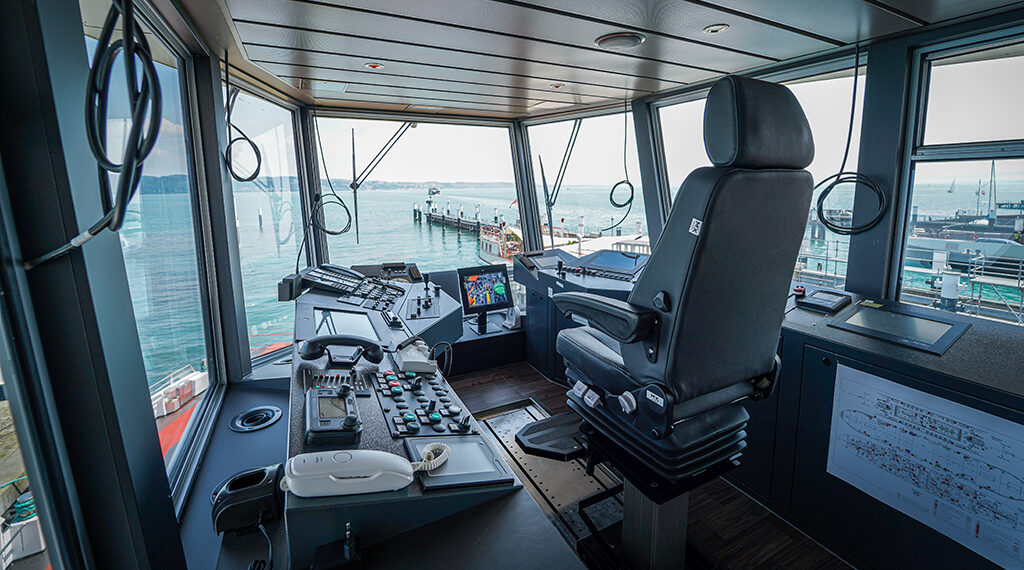
The command bridge is modern and functionally furnished.
Each lake crossing a 15-minute cruise
One ferry has just departed and another is already arriving – foot passengers and vehicles are streaming off the ship together and the next passengers are already waiting to embark. For commuters, day trippers and tourists, six ferries are in operation around the clock, 365 days a year. The shortcut across the lake saves 56 kilometres on the main road between Constance and Meersburg – many millions of vehicle kilometres and thousands of tonnes of emissions are avoided every year. Every lake crossing is different: the weather and the seasons make the boat trip an experience and a break to take a breather. Around 140 employees ensure that ferry operations run smoothly. At the beginning of the year, the staff was trained on the new energy source and the gas system.
First steam. Then diesel. Now gas propulsion!
Seen from the outside, “Richmond” resembles the Lake Constance ferry “Lodi”, which entered service in 2010. It is over 80 metres long and has a load capacity of 400 tonnes, allowing it to transport around 700 passengers and up to 64 cars. A striking feature of the new ship is the eight-metre-high ventilation mast, which is part of the gas plant’s safety system. What is new is the fact that the two 8-cylinder MTU engines, each producing 746 kilowatts, are pure gas engines. They are powered by liquefied natural gas instead of diesel fuel. The heart of the drive was developed and manufactured in Friedrichshafen by Rolls-Royce Power Systems under the MTU brand, i.e. in the region and in the direct vicinity less than 20 kilometres from Meersburg.
We are delighted to be using MTU gas engines from our long-standing partner Rolls-Royce Power Systems in the new member of our fleet.
Dr. Norbert Reuter, Constance Public Services’ Managing Director
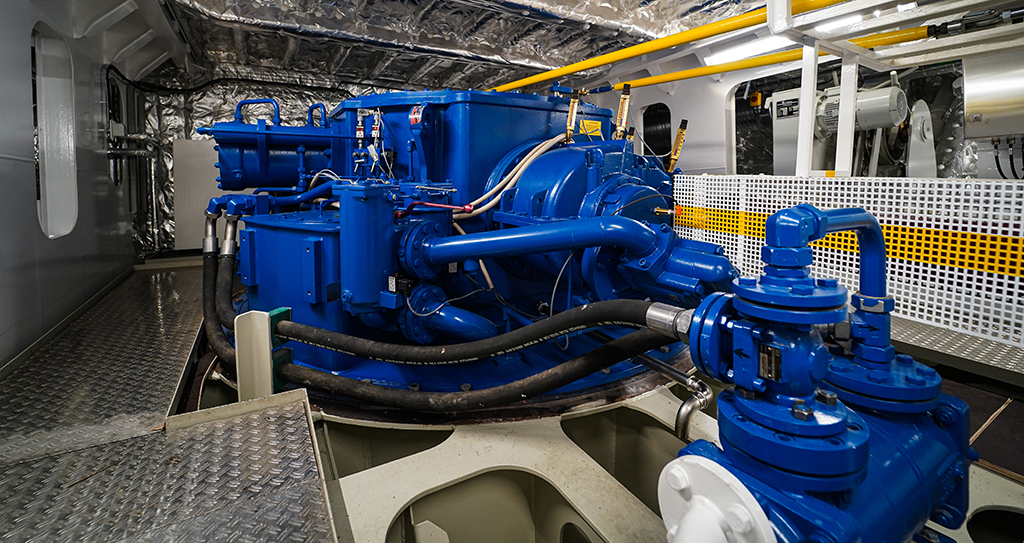
The Voith-Schneider propeller allows stepless variation for thrust and direction.
A propeller that can also steer
Another special feature of the ferry’s gas propulsion system is the propeller. It is not a classic propeller, but a Voith-Schneider propeller, and it works like this. Vertically movable and controllable blades are mounted on a circular disc on the ship’s underwater hull. The adjustment of the blades enables a stepless variation of thrust and direction. The conventional ship’s rudder can therefore be dispensed with. The Voith-Schneider propeller shows its advantages on ships that have to manoeuvre a lot, such as a ferry that makes many harbour manoeuvres every day.
560 tonnes of steel from Hamburg to Lake Constance
Construction of the new ferry began at a shipyard in Hamburg. The 17 sections of the ship, prefabricated here and measuring 13.5 by 4.5 metres, were brought to Lake Constance by special heavy transport lorries. Each section weighed over 30 tonnes, and a total of more than 560 tonnes of steel were moved. The hull assembly and interior fitting then took place in Fußach on Lake Constance in Austria. For the final finishing work, the ship was towed to its home port. At the end of 2022, the so-called wedding took place, which is the term used in shipbuilding for the installation of the engine.
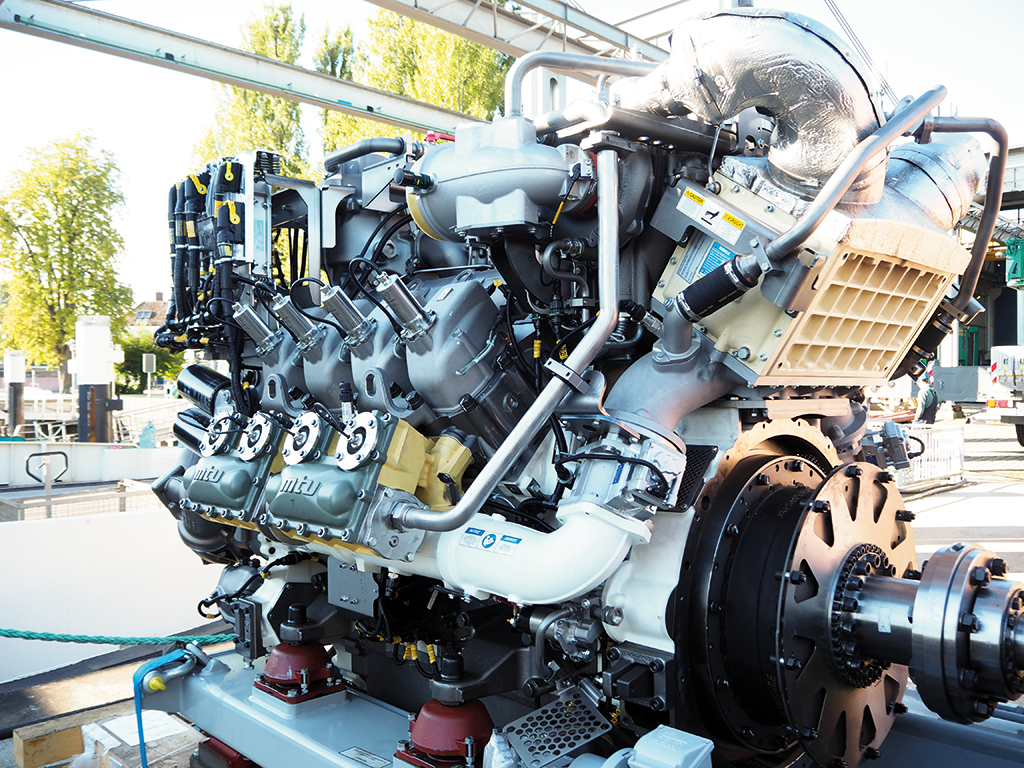
The new 8-cylinder MTU gas engine for ships was already humming on the test bench at the beginning of June 2019 and is now celebrating its premiere on the Lake Constance ferry.
The gas plant – safe and clean
Of course, safety is the primary concern with the gas system. The LNG, consisting of 98 percent methane, is colourless and non-toxic. LNG is obtained by cooling natural gas to –163 °C. The liquefied gas is delivered to the port once a week by trailer and bunkered directly in the ship’s storage tank. The LNG tanks of the “Richmond” are located in a room that is secured by a gas-tight pressure lock and thus virtually separated from the rest of the ship.
In the future, Richmond will be fuelled with bio-LNG, in which case it will be largely greenhouse gas neutral.
Christopher Pape, Constance Public Services’ Press Officer
All gas pipes are double-walled and equipped with integrated gas sniffers. The entire gas train and everything to do with LNG has been designed in accordance with the IGF Code, the standard of the International Maritime Organization (IMO). From the tank, the LNG flows into the Gas Processing Unit (GPU), where it is converted back into a gaseous state. The gas then flows into the engine, which drives the Voith-Schneider propellers and the shaft generator. The engine room and all other rooms connected to the gas system have forced ventilation. In the engine room, the air is changed thirty times per hour – i.e. every two minutes. Should overpressure occur in the system, the gas is safely led away from the ship via the ship’s eight-metre-high mast.
Better for the environment
The use of LNG is more environmentally friendly than ordinary marine diesel. Compared to diesel engines, the gas engine emits no soot particles and no sulphur dioxides, produces 90 percent less nitrogen oxides and 10 percent less CO2. Constance Public Services is interested in using biogas from renewable sources. Cooperation with regional suppliers is currently being examined. The ferry’s gas plant can also process bio-LNG – the ferry would then be powered in a largely greenhouse gas-neutral way.
The LNG ferry “Richmond” in figures
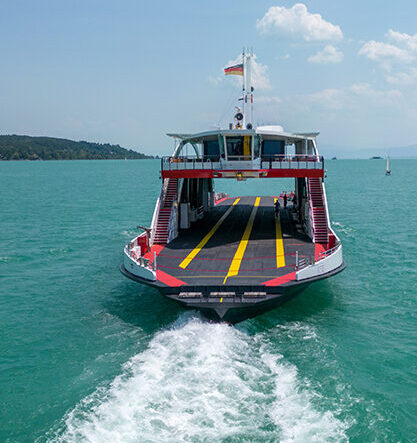
Investment: 24.7 million euros
Length: 82.5 metres
Width: 13.4 metres
Weight: approx. 840 tons
Passengers: 700
Vehicles: 64 cars
Load capacity: 400 tons
Engines: two 8-cylinder gas engines
Power per engine: 746 kilowatts

Stadtwerke Konstanz GmbH is a company owned by the city of Constance. It is one of the largest energy supply and transport companies on Lake Constance. In addition to energy and water supply, its core business includes the transport of passengers via the city bus service and the Constance – Meersburg ferry service. Constance Public Services has been resolutely investing in environmental protection measures and fuel-saving and low-emission engines for a considerable length of time.
Photos: Stadtwerke Konstanz, Achim Mende


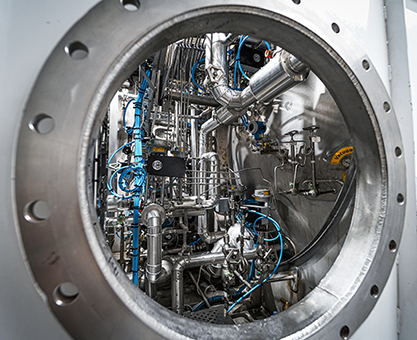
 Read the current digital customer magazine now!
Read the current digital customer magazine now!
